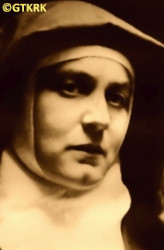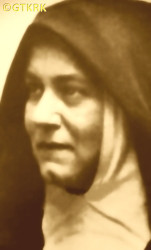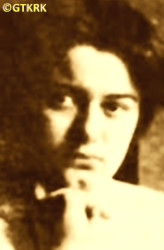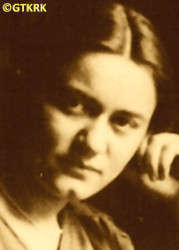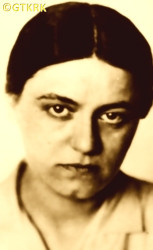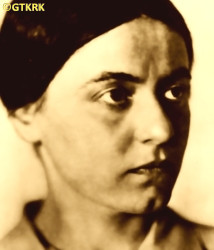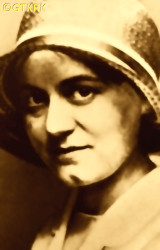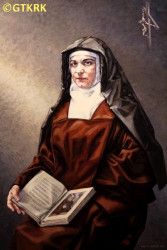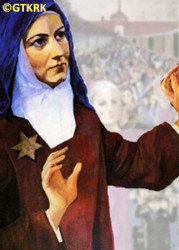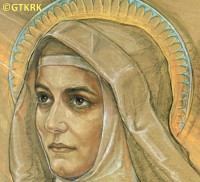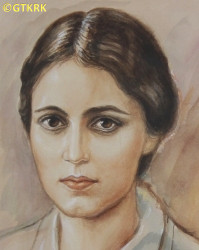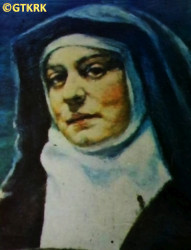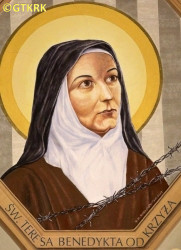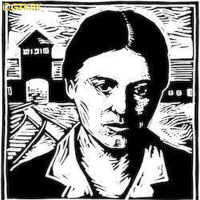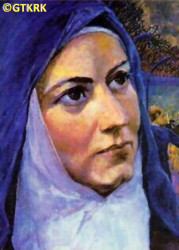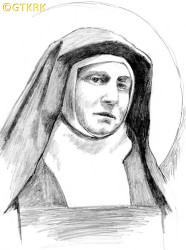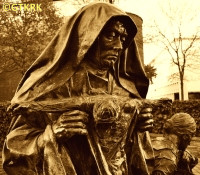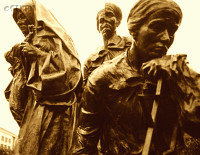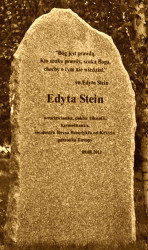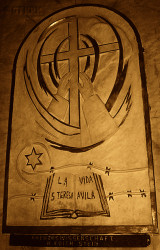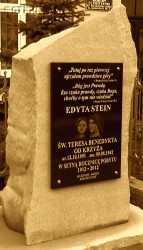Roman Catholic
St Sigismund parish
05-507 Słomczyn
85 Wiślana Str.
Konstancin deanery
Warsaw archdiocese, Poland
full list:
displayClick to display full list

searchClick to search full list by categories
wyświetlKliknij by wyświetlić pełną listę po polsku

szukajKliknij by przeszukać listę wg kategorii po polsku

Martyrology of the clergy — Poland
XX century (1914 – 1989)
personal data
religious status
saint
surname
STEIN
forename(s)
Edith Therese Hedwig (pl. Edyta Teresa Jadwiga)
religious forename(s)
Therese Benita of the Cross (pl. Teresa Benedykta od Krzyża)
function
nun
creed
Latin (Roman Catholic) Church RCmore on
en.wikipedia.org
[access: 2014.09.21]
congregation
Order of the Sisters of Discalced Carmelites OCDmore on
en.wikipedia.org
[access: 2013.05.19]
(i.e. Discalced Carmelite Nuns, Barefoot Carmelite Nuns)
academic distinctions
Doctor of Philosophy
nationality
German-Jewish
date and place
of death
09.08.1942

KL Auschwitzconcentration camp
today: Oświęcim, Oświęcim gm., Oświęcim pov., Lesser Poland voiv., Poland
more on
en.wikipedia.org
[access: 2022.01.09]
details of death
During World War I nurse of the Red Cross.
After training at All Saints Hospital in Wrocław ministered in a field hospital in Hranice in Moravia.
On 31.12.1938 moved to Echt monastery — as a prevention against persecution of Jews prevalent in Germany.
After German and Russian invasion of Poland in 09.1939 and start of the World War II, after invasion of Holland by the Germany in 05.1940, arrested by the Germans on 02.08.1942 — after the Dutch bishop's pastoral letter from 26.07.1942 condemning deportations of Dutch workers and Jews.
Taken to Germ. Durchgangslager Amersfoort (Eng. Amersfoort transit camp).
Two days later, on 04.08.1942, transferred to Germ. Judendurchgangslager Westerbork.
Finally on 07.08.1942 transported out to KL Auschwitz concentration camp where in KL Auschwitz II Birkenau subcamp murdered in a gas chamber.
cause of death
extermination: gassing in a gas chamber
perpetrators
Germans
sites and events
KL AuschwitzClick to display the description, Regierungsbezirk KattowitzClick to display the description, JDG WesterborkClick to display the description, Ribbentrop‐MolotovClick to display the description, Pius XI's encyclicalsClick to display the description
date and place
of birth
12.10.1891

Wrocławtoday: Wrocław city pov., Lower Silesia voiv., Poland
more on
en.wikipedia.org
[access: 2021.04.02]
parents
STEIN Siegfried
🞲 ?, Gliwicetoday: Gliwice city pov., Silesia voiv., Poland
more on
en.wikipedia.org
[access: 2021.04.02] — 🕆 1893, Goszcztoday: Twardogóra gm., Oleśnica pov., Lower Silesia voiv., Poland
more on
en.wikipedia.org
[access: 2021.04.02]

COURANT Augustina
🞲 04.10.1849, Lubliniectoday: Lubliniec urban gm., Lubliniec pov., Silesia voiv., Poland
more on
en.wikipedia.org
[access: 2021.04.02] — 🕆 14.09.1936, Wrocławtoday: Wrocław city pov., Lower Silesia voiv., Poland
more on
en.wikipedia.org
[access: 2021.04.02]
baptism
01.01.1922

Bad Bergzaberntoday: Südliche Weinstraße dist., Rhineland‐Palatinate state, Germany
more on
en.wikipedia.org
[access: 2024.03.25]
St Martin the Bishop and Confessor RC church
religious vows
21.04.1938 (permanent)
positions held
1938 – 1942
nun — Echttoday: Echt‐Susteren, Limburg prov., Niederlands
more on
en.wikipedia.org
[access: 2022.04.17] ⋄ monastery, Discalced Carmelite Nuns OCD
1933 – 1938
nun — Colognetoday: Cologne urban dist., Cologne reg., North Rhine‐Westphalia state, Germany
more on
en.wikipedia.org
[access: 2022.04.17] ⋄ monastery, Discalced Carmelite Nuns OCD
14.10.1933
accession — Colognetoday: Cologne urban dist., Cologne reg., North Rhine‐Westphalia state, Germany
more on
en.wikipedia.org
[access: 2022.04.17] ⋄ Discalced Carmelite Nuns OCD
1932 – 1933
associate professor — Münstertoday: Münster urban dist., Münster reg., North Rhine‐Westphalia state, Germany
more on
en.wikipedia.org
[access: 2021.07.18] ⋄ German Institute of Scientific Pedagogy
1923 – 1931
teacher — Speyertoday: Speyer urban dist., Rhineland‐Palatinate state, Germany
more on
en.wikipedia.org
[access: 2022.04.17] ⋄ lyceum for females and the Dominican Sisters' Teacher Training Institute at St Magdalene
from 1916
teacher — Wrocławtoday: Wrocław city pov., Lower Silesia voiv., Poland
more on
en.wikipedia.org
[access: 2021.04.02] ⋄ Latin, German, history and geography, Victoriaschule gymnasium (today: Danuta Siedzikówna „Inka” 1st Lyceum)
till 1916
PhD student — Freiburg im Breisgautoday: Freiburg im Breisgau urban dist., Freiburg reg., Baden‐Württemberg state, Germany
more on
en.wikipedia.org
[access: 2020.07.31] ⋄ philosophy, Albrecht and Louis University — PhD thesis „On the problem of empathy” (Germ. „Zum Problem der Einfühlung”)
from 1913
PhD student — Göttingentoday: Göttingen dist., Lower Saxony state, Germany
more on
en.wikipedia.org
[access: 2022.04.17] ⋄ philosophy, Georg August University (Germ. Georg–August–Universität Göttingen)
1911 – 1913
student — Wrocławtoday: Wrocław city pov., Lower Silesia voiv., Poland
more on
en.wikipedia.org
[access: 2021.04.02] ⋄ German philology, history and psychology, University of Wrocław [i.e. University of Wrocław (since 1945) / Frederic Wilhelm University of Silesia (1911‐1945) / Royal University i.e. Breslau Academy (1816‐1911)]
phenomenologist, Thomist, author of many scientific works, incl. „Opportunity and act” (Germ. „Potenz und Akt”), a work repeatedly rejected by German universities as a habilitation thesis (the German system did not include women in the structure of higher academic distinctions)
patroness of Europe
others related
in death
BOCKClick to display biography Therese Christine Mary Clementine (Sr Charitas), LÖBClick to display biography Dorothea (Sr Mary Therese), LÖBClick to display biography Ernest (Fr Nivardus), LÖBClick to display biography George (Fr Ignatius), LÖBClick to display biography Lien (Sr Hedwig), LÖBClick to display biography Robert (Bro. Linus), LÖWENFELSClick to display biography Luise (Sr Mary Aloysia), MENDES da COSTAClick to display biography Judith Henrietta, MICHAELISClick to display biography Else Sarah (Sr Miriam), REISClick to display biography Alice (Sr Mary Benita of the Cross), ROSENBAUMClick to display biography Fritz (Bro. Wolfgang)
sites and events
descriptions
KL Auschwitz: German Germ. Konzentrationslager (Eng. concentration camp) KL and Germ. Vernichtungslager (Eng. extermination camp) VL Auschwitz was set up by Germans around 27.01.1940 n. Oświęcim, on the German territory (initially in Germ. Provinz Schlesien — Silesia Province; and from 1941 Germ. Provinz Oberschlesien — Upper Silesia Province). Initially mainly Poles were interned. From 1942 it became the centre for holocaust of European Jews. Part of the KL Auschwitz concentration camps’ complex was Germ. Vernichtungslager (Eng. extermination camp) VL Auschwitz II Birkenau, located not far away from the main camp. There Germans murdered likely in excess of million people, mainly Jews, in gas chambers. In KL Auschwitz alone, the Germans murdered c. 30,000 prisoners by lethal injection. Until 1941, people were killed by intravenous injections of concentrated hydrogen peroxide, ether, hydrogen peroxide, or gasoline. Later, an intracardiac injection was used — with a needle about 10 cm long — of 10‐15 ml of a 30% solution of phenol C6H5OH (acquired from the German concern IG Farben, or more precisely from its subsidiary Bayer, and still used by Bayer AG, among others, for the production of aspirin), which killed within 15 seconds. Altogether In excess of 400 priests and religious went through the KL Auschwitz, c. 40% of which were murdered (mainly Poles). (more on: en.auschwitz.org.plClick to attempt to display webpage
[access: 2012.11.23], www.meczennicy.pelplin.plClick to attempt to display webpage
[access: 2013.07.06])
Regierungsbezirk Kattowitz: After the Polish defeat in the 09.1939 campaign, which was the result of the Ribbentrop‐Molotov Pact and constituted the first stage of World War II, and the beginning of German occupation in part of Poland (in the other, eastern part of Poland, the Russian occupation began), the Germans divided the occupied Polish territory into five main regions (and a few smaller). The largest one was transformed into Germ. Generalgouvernement (Eng. General Governorate), intended exclusively for Poles and Jews and constituting part of the so‐called Germ. Großdeutschland (Eng. Greater Germany). From two separate new provinces were created. The two remaining were incorporated into existing German provinces. One of those was Polish Upper Silesia, which on 08.09.1939, by decree of the German leader Adolf Hitler (formally came into force on 26.10.1939), was incorporated into Germany as the Germ. Regierungsbezirk Kattowitz (Eng. Katowice Regency) and became part of the Germ. Provinz Schlesien (Eng. Province of Silesia) based in Wrocław. On 01.04.1940, the Germ. Regierungsbezirk Kattowitz was enlarged by several pre‐war German counties, and on 18.01.1941, a new German province was created, the Germ. Provinz Oberschlesien (Eng. Province of Upper Silesia), which, apart from the Germ. Regierungsbezirk Kattowitz, also included the Opole region. From 26.10.1939, when the regency was established, the law of the German state was in force there, the same as in Berlin. The main axis of the policy of the new regency, the territory of which the Germans recognized as the Germ. „Ursprünglich Deutsche” (Eng. „natively German”), despite the fact only 6% of its pre–war Polish part were Germans, was Germ. „Entpolonisierung” (Eng. „Depolonisation”), i.e. forced Germanization. The main mechanism was the introduction of the Germ. Deutsche Volksliste DVL, a German nationality list that was supposed to specify the national affiliation of the inhabitants of the region. The largest group marked in the compulsory registrations was Group 3, people who identified themselves as „Silesians” (in 1943 about 41%), and people remaining outside the DVL (about 36%). The latter group was intended to be deported to the Germ. Generalgouvernement (which did not happen en masse because German industry needed slave labor). Group 3, considered by the Germans as capable of Germanization, was subject to certain legal restrictions, and was subject to, among others, to conscription into the German Wehrmacht army. Children could only learn in German. A policy of terror was pursued against the Polish population. There was a special police court, controlled by the Germ. Geheime Staatspolizei (Eng. Secret State Police), i.e. the Gestapo, before which c. 4,000‐5,000 people were detained. For the years 1942‐1945 over 2,000 of them were verified, of which 1,890 were sentenced to death, including 286 in public executions. Thousands of people were murdered during the so‐called «Intelligenzaktion Schlesien», including 300‐650 Polish teachers and c. 61 Polish Catholic priests. The regency hosted a German concentration and extermination camp KL Auschwitz, where the Germans imprisoned c. 1,100,000 Jews (murdering c.1,000,000, i.e. c. 90% of them) and c. 140,000 Poles (murdering c. 70,000, i.e. c. 50% of them). After the end of hostilities of World War II, the overseer of this province, the Germ. Reichsstatthalter (Eng. Reich Governor) and the Germ. Gauleiter (Eng. district head) of the German National Socialist Party, Fritz Brecht, committed suicide. (more on: en.wikipedia.orgClick to attempt to display webpage
[access: 2024.06.24])
JDG Westerbork: Transit camp for Jews (Germ. Judendurchgangslager) set up by Germans in Westerbork in Drenthe province in Holland. Operational in 1942‐1945. Each Tuesday, from 07.1942 till 09.1944 a transport was dispatched, mainly to KL Auschwitz II Birkenau (65 train loads, c. 60,330 people) and Sobibór (19 train loads; c. 34,313 people) death camps. Almost all were murdered. Altogether c. 97,776 people wre sent out from JDG Westerbork. (more on: en.wikipedia.orgClick to attempt to display webpage
[access: 2020.06.02])
Ribbentrop‐Molotov: Genocidal Russian‐German alliance pact between Russian leader Joseph Stalin and German leader Adolf Hitler signed on 23.08.1939 in Moscow by respective foreign ministers, Mr. Vyacheslav Molotov for Russia and Joachim von Ribbentrop for Germany. The pact sanctioned and was the direct cause of joint Russian and German invasion of Poland and the outbreak of the World War II in 09.1939. In a political sense, the pact was an attempt to restore the status quo ante before 1914, with one exception, namely the „commercial” exchange of the so‐called „Kingdom of Poland”, which in 1914 was part of the Russian Empire, fore Eastern Galicia (today's western Ukraine), in 1914 belonging to the Austro‐Hungarian Empire. Galicia, including Lviv, was to be taken over by the Russians, the „Kingdom of Poland” — under the name of the General Governorate — Germany. The resultant „war was one of the greatest calamities and dramas of humanity in history, for two atheistic and anti‐Christian ideologies — national and international socialism — rejected God and His fifth Decalogue commandment: Thou shall not kill!” (Abp Stanislav Gądecki, 01.09.2019). The decisions taken — backed up by the betrayal of the formal allies of Poland, France and Germany, which on 12.09.1939, at a joint conference in Abbeville, decided not to provide aid to attacked Poland and not to take military action against Germany (a clear breach of treaty obligations with Poland) — were on 28.09.1939 slightly altered and made more precise when a treaty on „German‐Russian boundaries and friendship” was agreed by the same murderous signatories. One of its findings was establishment of spheres of influence in Central and Eastern Europe and in consequence IV partition of Poland. In one of its secret annexes agreed, that: „the Signatories will not tolerate on its respective territories any Polish propaganda that affects the territory of the other Side. On their respective territories they will suppress all such propaganda and inform each other of the measures taken to accomplish it”. The agreements resulted in a series of meeting between two genocidal organization representing both sides — German Gestapo and Russian NKVD when coordination of efforts to exterminate Polish intelligentsia and Polish leading classes (in Germany called «Intelligenzaktion», in Russia took the form of Katyń massacres) where discussed. Resulted in deaths of hundreds of thousands of Polish intelligentsia, including thousands of priests presented here, and tens of millions of ordinary people,. The results of this Russian‐German pact lasted till 1989 and are still in evidence even today. (more on: en.wikipedia.orgClick to attempt to display webpage
[access: 2015.09.30])
Pius XI's encyclicals: Facing the creation of two totalitarian systems in Europe, which seemed to compete with each other, though there were more similarities than contradictions between them, Pope Pius XI issued in 03.1937 (within 5 days) two encyclicals. In the „Mit brennender Sorge” (Eng. „With Burning Concern”) published on 14.03.1938, condemned the national socialism prevailing in Germany. The Pope wrote: „Whoever, following the old Germanic‐pre‐Christian beliefs, puts various impersonal fate in the place of a personal God, denies the wisdom of God and Providence […], whoever exalts earthly values: race or nation, or state, or state system, representatives of state power or other fundamental values of human society, […] and makes them the highest standard of all values, including religious ones, and idolizes them, this one […] is far from true faith in God and from a worldview corresponding to such faith”. On 19.03.1937, published „Divini Redemptoris” (Eng. „Divine Redeemer”), in which criticized Russian communism, dialectical materialism and the class struggle theory. The Pope wrote: „Communism deprives man of freedom, and therefore the spiritual basis of all life norms. It deprives the human person of all his dignity and any moral support with which he could resist the onslaught of blind passions […] This is the new gospel that Bolshevik and godless communism preaches as a message of salvation and redemption of humanity”… Pius XI demanded that the established human law be subjected to the natural law of God , recommended the implementation of the ideal of a Christian state and society, and called on Catholics to resist. Two years later, National Socialist Germany and Communist Russia came together and started World War II. (more on: www.vatican.vaClick to attempt to display webpage
[access: 2023.05.28], www.vatican.vaClick to attempt to display webpage
[access: 2023.05.28])
sources
personal:
pl.wikipedia.orgClick to attempt to display webpage
[access: 2014.03.21], polska-org.plClick to attempt to display webpage
[access: 2021.12.19]
bibliographical:
„Edith Stein and Companions. On the way to Auschwitz”, Fr Paul Hammans, 2010, San Francisco
original images:
www.muzeum.miejskie.wroclaw.plClick to attempt to display webpage
[access: 2014.03.21], kosciol.wiara.plClick to attempt to display webpage
[access: 2020.06.02], stacja7.plClick to attempt to display webpage
[access: 2020.06.02], edytastein.org.plClick to attempt to display webpage
[access: 2020.06.02], pl.aleteia.orgClick to attempt to display webpage
[access: 2020.06.02], pl.aleteia.orgClick to attempt to display webpage
[access: 2020.06.02], commons.wikimedia.orgClick to attempt to display webpage
[access: 2020.06.02], lubimyczytac.plClick to attempt to display webpage
[access: 2020.06.02], communiocrucis.plClick to attempt to display webpage
[access: 2020.06.02], m.interia.plClick to attempt to display webpage
[access: 2020.06.02], polska-org.plClick to attempt to display webpage
[access: 2021.12.19], m.niedziela.plClick to attempt to display webpage
[access: 2020.06.02], www.niedziela.plClick to attempt to display webpage
[access: 2020.06.02], wroclaw.gosc.plClick to attempt to display webpage
[access: 2020.06.02], sprzedajemy.plClick to attempt to display webpage
[access: 2020.06.02], kobieta.interia.plClick to attempt to display webpage
[access: 2020.06.02], www.facebook.comClick to attempt to display webpage
[access: 2020.06.02], bdp.xportal.plClick to attempt to display webpage
[access: 2020.06.02], www.ssb24.plClick to attempt to display webpage
[access: 2020.06.02], rk.karelia.ruClick to attempt to display webpage
[access: 2018.11.18], kosciol.wiara.plClick to attempt to display webpage
[access: 2014.03.21], wroclawskieklimaty.bloog.plClick to attempt to display webpage
[access: 2014.03.21], en.wikipedia.orgClick to attempt to display webpage
[access: 2014.03.21], www.wolnyportal.plClick to attempt to display webpage
[access: 2014.03.21]
LETTER to CUSTODIAN/ADMINISTRATOR
If you have an Email client on your communicator/computer — such as Mozilla Thunderbird, Windows Mail or Microsoft Outlook, described at WikipediaPatrz:
en.wikipedia.org, among others — try the link below, please:
LETTER to CUSTODIAN/ADMINISTRATORClick and try to call your own Email client
If however you do not run such a client or the above link is not active please send an email to the Custodian/Administrator using your account — in your customary email/correspondence engine — at the following address:

giving the following as the subject:
MARTYROLOGY: STEIN Edith Therese Hedwig
To return to the biography press below:
 Click to return to biography
Click to return to biography








